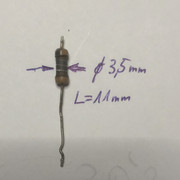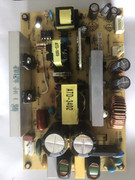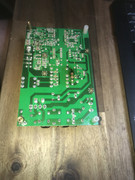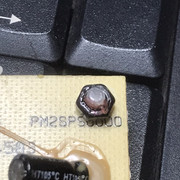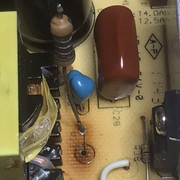|
|
Post by tjmotter on Jan 27, 2021 20:47:43 GMT -5
thank you for the answer. I don't wish I had misled you. The power relay, when as the Q181 transistor closes ground circuit, the amplifier works perfectly. If I turn ON the amplifier, I have no problem, everything works fine! I have the problem in standby or if I activate the hdmi-passtrought mode, in that case, on the base/gate of the transistor Q181 arrive, making up and down, floating, the 3v ((0~3~0~3V ecc). So the main tension goes up and down and I hear the clicks! If I turn ON the amplifier, the Q181 transistor receives the 3v on the gate, relay works correctly. Now I am waiting for the spare Q181 transistor, but I suspect a problem related to the standby mode, I am only sorry that I was unable to decipher/understand in standby/passtrouh zone the schematic.  A transistor can blow in multiple different ways. In many cases, the transistor blows into a "short". In other cases, it blows into an "open". In my experience, the majority of designs I have seen that use a transistor as a "switch" it is used to turn power on to a circuit. In this Onkyo design, it does the opposite. By this I mean when switched on, the transistor provides a path to ground instead of providing a path for the voltage. If you look at the diagram in the attached link: en.wikipedia.org/wiki/Bipolar_junction_transistor you can see that for a transistor to blow into a short, the doping layers would have to start to break down. My working theory here is that Q181 is starting to fail and the most likely cause is the doping layer between the base and the emitter. This would provide some leakage from the emitter to the base and could cause the symptoms you are seeing. Essentially, when you turn it off, leakage from the emitter to the base is causing it to turn on. Once this "mini charge" is depleted, it cycles off and then recharges causing the cycling you are seeing. Now, i could be wrong but this theory is plausible to me simply because this circuit design is a bit odd.
HTH
Todd
|
|
|
|
Post by hiroshi976 on Jan 30, 2021 11:17:19 GMT -5
Thanks again Todd. I'm waiting for the replacement transistor. So this transistor also has biasing, so internal resistors could theoretically cause problems as well.( or no?)
|
|
|
|
Post by tjmotter on Jan 31, 2021 21:06:43 GMT -5
Yes, if that resistor is degraded it could cause the same symptoms.
|
|
|
|
Post by hiroshi976 on Feb 3, 2021 11:55:55 GMT -5
Yes, if that resistor is degraded it could cause the same symptoms. Hi. Yesterday the replacement transistors finally arrived and I have installed the new transistor. I also replaced the D925 diode, I didn't have a smd, and I installed a 1n4148 (same characteristics). I Check again the relay and the R921 resistor (it was 46.7Ohm) and the capacitors present (all perfect). I tested the old RN1405 transistor (on the table!), The junctions seemed to be ok with diode test, but with the dmm in Ohm set, I detected between B and E, with the positive on B, 44 K, inverting the leads, 47K . The new RN1405, 50K and 54K respectively. Instead the old RN1405, between B and C, with lead positive on B, about 12.30 MOhm, inverting leads, have OL. The new RN1405 instead 13.50 MOhm and reversing leads, have OL. Between E and C, old, 12.10 MOhm, and inverting leads OL, new transistor have the value of 13.70 MOhm. I'm starting to think that it was a problem with the resistive bias network of the old transistor. At the moment, the problem has not recurred. (fingers crossed!  )
 |
|
|
|
Post by tjmotter on Feb 3, 2021 20:22:41 GMT -5
Looking at the datasheet for the RN1405 I would expect to see a B to E measurement of 49.2 Kohms. The primary resistor (R1 -base pin to the base of the transistor) should be 2.2K ohms and the secondary resistor (R2 - base of the resistor to the emitter pin) should be 47K ohms. As you noted, the measurements on the transistor you removed are significantly lower. I suspect this caused the transistor to switch on unpredictably. Once on it would work fine but with too low of a resistance on the base resistor, it could think it was a signal to turn on, completing the ground.
If you think about how this circuit works it makes even more sense. When the system is turned off, there will be 12V on the emitter but since this transistor is internally biased, this voltage will have to travel through the 47K ohm resistor which would drive its voltage down so that it can't trigger the transistor to turn on but if this resistor is degraded, the voltage on the base would increase. If it gets to a point where it is enough to turn on the transistor, you would see the cycling you described. This seems to align with your measurements as well since the Base to Emitter resistance is clearly lower than the new part.
So net/net, I agree with your assessment. |
|
|
|
Post by hiroshi976 on Feb 4, 2021 12:42:09 GMT -5
Is 2 days which it works perfectly. Probably the defect was caused because I used it for 10 years, with the hdmi passtrought active. So the transistor remained on continuously for 10 years! : D Thank you so much for helping me, Todd! You are great!  |
|
|
|
Post by raz777 on Mar 16, 2023 18:12:28 GMT -5
The 12V on the collector is normal. It is simply feeding the voltage through the relay. Once the collector goes to ground it triggers the circuit. The relay is simply a piece of wire so when there is no ground, you will always see 12V on this line. In reality, this voltage should drop to 9V once ground is applied because the 47ohm resistor will pull the voltage down. The diode is there simply to protect against the inrush current when the transistor switches to ground. I suggested replacing Q181 near the beginning of this thread but you insisted it was working properly. Change it and let us know what happens. Hi I think I have this same problem on my onkyo tx-sr608, mine is just clicking won't come out of standby. I have tested the relay and 47ohm resister, both ok. Am wondering where Q181 is, what value etc? Thanks
|
|
|
|
Post by tjmotter on Mar 17, 2023 21:16:17 GMT -5
|
|
|
|
Post by raz777 on Mar 19, 2023 3:20:11 GMT -5
Thank you so much- your the best. |
|


 )
)


